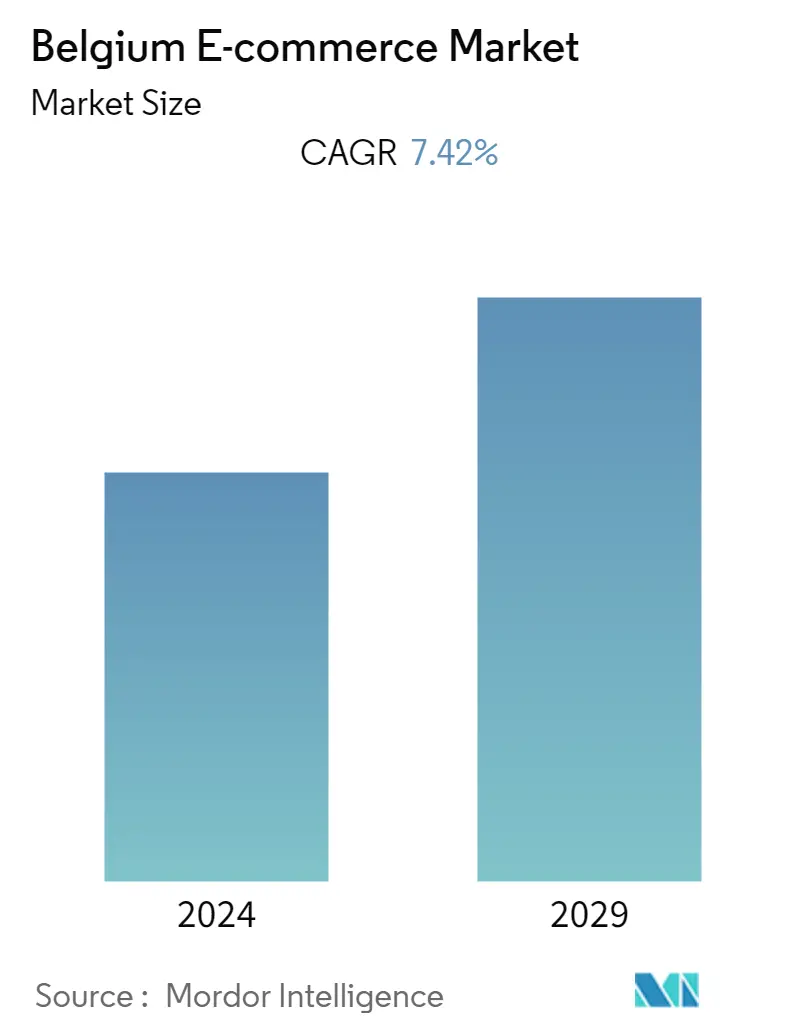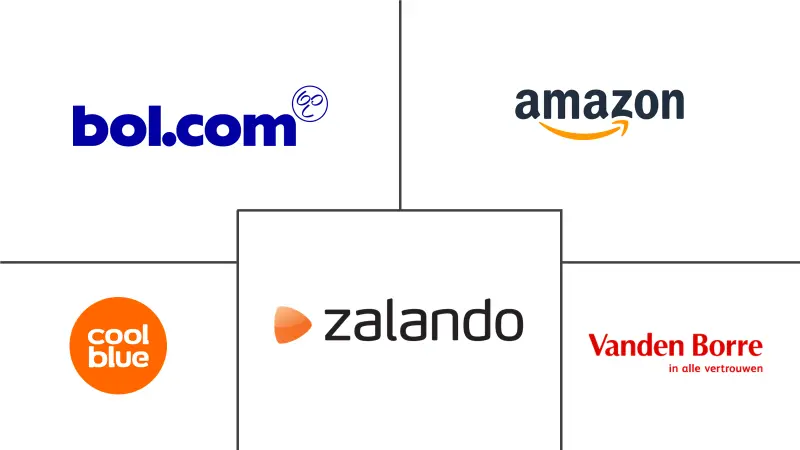Market Size of Belgium E-commerce Industry

| Study Period | 2019 - 2029 |
| Base Year For Estimation | 2023 |
| Forecast Data Period | 2024 - 2029 |
| Historical Data Period | 2019 - 2022 |
| CAGR | 7.42 % |
| Market Concentration | Medium |
Major Players
*Disclaimer: Major Players sorted in no particular order |
Belgium E-Commerce Market Analysis
The Belgium E-commerce market is anticipated to register a CAGR of 7.42% over the forecast period from 2022 to 2027. There has been a significant increase in the adoption of digital commerce recently as internet penetration has increased in the country. Further, companies such as Amazon expanding its services in the country have fueled the adoption of e-commerce.
- The International Trade Administration stated that, in 2020, there had been an increase in online purchases by 7.5%, with a turnover of USD 10.4 billion in Belgium. Further, Flanders, Wallonia, and Brussels have developed procedures to promote the business as they offer incentives such as grants and tax cuts for e-commerce.
- In Belgium, the E-commerce sector is regulated by common commercial law. In May 2021, Belgium announced alignment with the EU e-commerce VAT package. As a result, all the B2C sales had to be charged VAT on a distance selling basis, which also affected the imports e-commerce rules in the region. Further, the government plans to consider a roll-out of Digital Service tac (DST) of 3% on e-commerce.
- The increase in e-commerce in the region has been influenced by early internet adoption and early internet infrastructure development. Also, with the pandemic's emergence, the region's e-commerce market has witnessed enormous growth as the lockdowns and Covid restrictions have forced the shoppers to adapt to online retail and shopping.
- During the COVID-19 pandemic, card payments became Belgium customers' most preferred payment mode. Moreover, a significant portion of people in the country makes online transactions through mobile phones, indicating the acceptance and comfort of using mobile-based payments. However, when it comes to preference for paying a significant amount of money online, most of the customers in the country still opt for laptops and desktops for transactions.
Belgium E-Commerce Industry Segmentation
B2 B E-commerce and B2C E-commerce segment the Belgium e-commerce market. By B2C E-commerce, the market studied is further subdivided into beauty & personal care, consumer electronics, fashion & apparel, food & beverage, and furniture & home. The report studies the impact of covid-19 on the studied market.
| By B2C E-commerce | ||||||||
| Market size (GMV) for the period of 2017-2027 | ||||||||
|
| By B2B E-commerce | |
| Market size for the period of 2017-2027 |
Belgium E-commerce Market Size Summary
The Belgium e-commerce market is experiencing robust growth, driven by increased internet penetration and the expansion of major players like Amazon. The adoption of digital commerce has been further accelerated by the COVID-19 pandemic, which forced consumers to shift towards online shopping due to lockdowns and restrictions. The market is supported by favorable government policies in regions like Flanders, Wallonia, and Brussels, which offer incentives such as grants and tax cuts to promote e-commerce. The sector is regulated under common commercial law, with recent alignments to the EU e-commerce VAT package impacting B2C sales and imports. The rise in digital payments, facilitated by high-speed internet access and the availability of mobile payment options, has also contributed to the market's expansion.
The fashion e-commerce segment in Belgium has seen significant growth, with consumers increasingly turning to online platforms for fashion purchases, including second-hand goods. The pandemic-induced store closures have led to a surge in online fashion sales, and this trend continues even as restrictions have eased. The market is characterized by a competitive landscape, with companies like Coolblue, Alibaba's Cainiao Network, and others investing in logistics and infrastructure to enhance their service offerings. The introduction of advanced logistics solutions, such as automated sorting systems, underscores the commitment to improving operational efficiency. As consumers become more discerning, comparing prices and seeking the best deals online, the e-commerce market in Belgium is poised for continued growth, supported by technological advancements and strategic investments.
Belgium E-commerce Market Size - Table of Contents
-
1. MARKET INSIGHTS
-
1.1 Market Overview
-
1.2 Industry Attractiveness-Porter's Five Forces Analysis
-
1.2.1 Bargaining Power of Suppliers
-
1.2.2 Bargaining Power of Buyers
-
1.2.3 Threat of New Entrants
-
1.2.4 Threat of Substitute Products
-
1.2.5 Intensity of Competitive Rivalry
-
-
1.3 Key Market Trends and Share of E-commerce of Total Retail Sector
-
1.4 Impact of COVID-19 on the E-commerce Sales
-
-
2. MARKET SEGMENTATION
-
2.1 By B2C E-commerce
-
2.1.1 Market size (GMV) for the period of 2017-2027
-
2.1.2 Market Segmentation - by Application
-
2.1.2.1 Beauty & Personal Care
-
2.1.2.2 Consumer Electronics
-
2.1.2.3 Fashion & Apparel
-
2.1.2.4 Food & Beverage
-
2.1.2.5 Furniture & Home
-
2.1.2.6 Others (Toys, DIY, Media, etc.)
-
-
-
2.2 By B2B E-commerce
-
2.2.1 Market size for the period of 2017-2027
-
-
Belgium E-commerce Market Size FAQs
What is the current Belgium E-commerce Market size?
The Belgium E-commerce Market is projected to register a CAGR of 7.42% during the forecast period (2024-2029)
Who are the key players in Belgium E-commerce Market?
bol.com, Coolblue, Amazon, Zalando and Vanden Borre NV are the major companies operating in the Belgium E-commerce Market.

